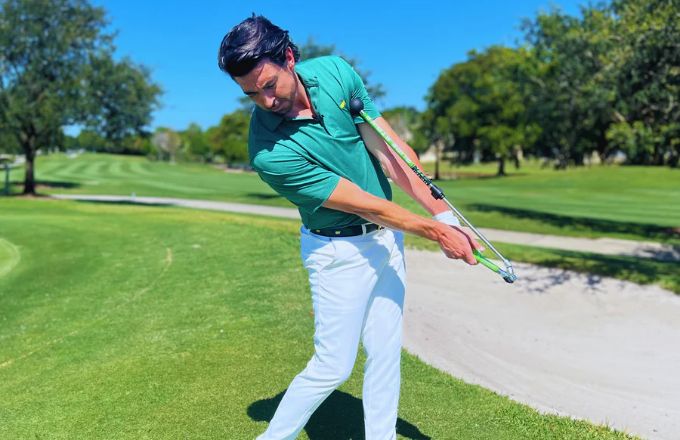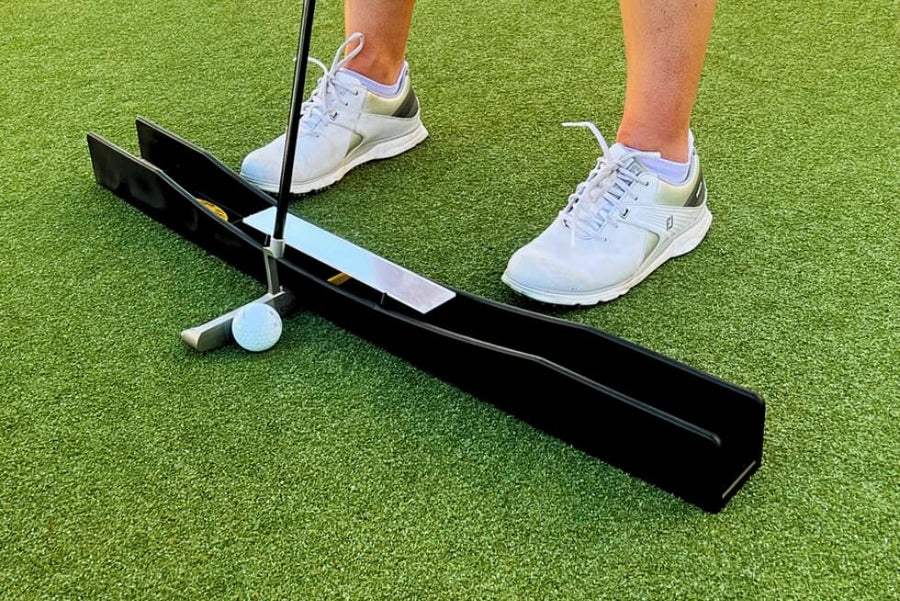Mastering the golf swing is akin to learning a complex dance. It’s an intricate blend of power, precision, and grace, meticulously executed to drive the ball towards its target. For many of the more than 119 million Americans who golfed last year, improving golf swing techniques becomes a lifelong journey of refinement and discovery. Yet, there’s beauty in the process—a meticulous transformation that unfolds with every practice session. To make this journey smoother and more rewarding, a roadmap with some insightful golf swing tips can be invaluable.
We've curated a list of the best golf swing tips tailored for players at every level. Whether you're just starting to navigate the fairways or you're a seasoned golfer looking to shave off a few strokes, this guide is your ally. It's more than just advice; it's a strategic approach to evolve your game from the ground up. These universally applicable tips are set to improve your golf swing, fortify your skills, and lay down a robust foundation for consistent improvement.
In the spirit of progress, let’s step onto the tee box with the first essential golf swing tip that could make all the difference in your game.
- Tip #1: Establish a Solid Foundation
- Tip #2: Perfect Your Grip
- Tip #3: Master Your Stance and Posture
- Tip #4: Control Your Tempo
- Tip #5: Optimize Your Backswing
- Tip #6: Fine-Tune Your Downswing
- Tip #7: Focus on Follow-Through
- Tip #8: Utilize Swing Thoughts Effectively
- Tip #9: Implement Training Aids in Your Practice
- Tip #10: Analyze and Adjust
Tip #1: Establish a Solid Foundation
Every majestic building starts with a steadfast base, and the golf swing is no different. The foundation of a golf swing is composed of three critical elements: stance, grip, and posture. If you're wondering how to perfect your golf swing, remember that neglecting any of these can lead to a domino effect of inaccuracies in your game. To improve your golf swing, focus on these three pieces.
Stance
Your feet are the anchor of your swing. Position them shoulder-width apart, parallel to the target line, offering a balance of stability and mobility. This width is crucial; too narrow, and you risk being unsteady—too wide, and you may hinder your rotation. For those focused on improving golf swing techniques, think of your stance like the roots of a tree, your stance should ground you yet allow for fluid motion.
Grip
The grip is your only physical connection to the club thus it's pivotal to get it right. A neutral grip, where both hands work together as a unit, is often recommended. Your hands should hold the club firmly yet not too tightly, with the pressure akin to holding a bird without letting it fly away or squeezing it too tight. When exploring golf swing tips, consider the grip styles—interlocking, overlapping, or ten-finger—and choose one that feels natural and allows for control without tension.
Posture
Good posture sets the stage for a dynamic and powerful swing. Stand tall, with a slight bend at the hips and knees, keeping your back straight but not rigid. Let your arms hang down naturally as you lean forward from the waist. This poised but relaxed posture enables a full turn and a proper swing plane, key elements for an effective golf swing.
By giving attention to these foundational golf swing tips, you're setting yourself up for success. And to aid in this mission, golf swing trainers can be incredibly beneficial. They reinforce the fundamentals, ensuring your foundation is not just established but also strong enough to build upon as you progress.
Shop Golf Swing TrainersTip #2: Perfect Your Grip
The influence of your grip on the golf swing cannot be overstated. It's the sole link between your body and the club, and it plays a pivotal role in the flight of the ball. One of the best golf swing tips you can get is that a flawed grip can lead to a cascade of errors in your swing, while a perfected grip can enhance consistency and power.
The Neutral Grip
A neutral grip can be the golden key to unlocking a reliable and efficient swing. Place your lead hand (left hand for right-handed golfers, right hand for lefties) on the club so that the thumb points down the shaft. The V formed by the thumb and forefinger should point towards your trailing shoulder. The trailing hand then complements this position, mirroring the lead hand. Among the many tips for golf swing improvement, mastering this grip encourages the clubface to return to a square position at impact, essential for straight shots.
Grip Pressure
Finding the sweet spot in grip pressure is essential. Imagine a scale from one to ten, where one is the lightest hold, and ten is the tightest. Aim for a grip pressure of around four or five. Among the most effective golf swing tips, this moderate grip pressure allows for a wrist hinge and the release of the club, both necessary for a fluid swing and maximum distance.
Grip Adjustments
Be aware that the grip might need slight adjustments for different clubs and shots. For instance, a firmer grip might be necessary in scenarios where control takes precedence over distance, such as in windy conditions or when playing out of the rough. Making these adjustments is key to improving golf swing performance and adapting to various game situations.
To truly perfect your grip, consider using a training aid like The Connector. It's designed to optimize hand placement and pressure, leading to a more consistent and powerful connection with the ball.
Browse Golf Grip Training AidsTip #3: Master Your Stance and Posture
Your stance and posture are the framework that supports every phase of the swing. They determine the quality of your ball striking and the consistency of your shots. Getting them right is a prerequisite for any golfer if you are aiming to perfect your golf swing.
Stance Width and Ball Position
The width of your stance should adjust slightly based on the club you're using. With longer clubs like the driver, a wider stance is beneficial for stability. For shorter irons, a narrower stance can improve precision. Ball position is equally crucial among essential golf swing tips; for long clubs, play the ball forward in your stance, and for shorter clubs, more towards the middle.
Dynamic Posture
Your posture should be dynamic, not static. It needs to allow for movement. Start with a straight back and then tilt from the hips, keeping the spine angle consistent throughout the swing. This dynamic posture is essential for a proper rotation and weight shift during the swing.
Balance and Weight Distribution
Balance your weight evenly on the balls of your feet, not the toes or heels. This poised stance allows for a nimble yet controlled swing. If you're wondering how to perfect your golf swing, focus on having your weight flow smoothly from the inside of the back foot to the inside of the front foot—a sign of proper weight transfer and balance.
For those looking to refine their stance and posture, the Sure-Strike training aid can be an invaluable tool. It encourages a balanced setup and a precise strike, which can be felt immediately upon use.

Tip #4: Control Your Tempo
One of the secrets to a smooth, powerful swing is mastering the tempo. Tempo refers to the rhythm and pace of your swing - from the takeaway to the follow-through. It's not about speed but about how the speed is distributed throughout the swing. When you are considering how to improve your golf swing, a harmonious tempo allows every component of the swing to fire in the correct sequence for optimal power and accuracy.
The 3:1 Ratio
Many seasoned golfers abide by a 3:1 tempo ratio, meaning the backswing takes three times as long as the downswing. This isn't a strict rule, but it's a guideline that promotes a controlled and measured approach, which is essential for improving golf swing consistency and preventing the rush that leads to errors.
Drill for Tempo
Try the "whoosh" drill to improve your tempo. Turn your club upside down and swing it so that you hear the "whoosh'"sound in the same spot every time. This drill can help you find a consistent, smooth pace for your swing.
Mental Metronome
Consider using a mental metronome or a physical one during practice. Start your swing on a beat and strive to hit the ball on a precise count. Among helpful golf swing tips, this technique can instill a rhythmic tempo that translates to muscle memory over time.
To further refine your tempo, the Right Angle golf training aid can be a great addition to your practice routine. It assists in keeping the arms and body in sync, which is crucial for a rhythmic and effective golf swing.
Tip #5: Optimize Your Backswing
The backswing sets the stage for the type of shot you're going to hit. It's not just about how far back you can go; it's about maintaining the correct form and position to enable a powerful and accurate downswing.
Rotation Over Extension
A common misconception is the need for a long backswing to hit the ball far. However, the quality of rotation is more important than the length of the extension. Among effective golf swing tips, focusing on rotating your shoulders and hips, keeping the lead arm straight, and ensuring the clubhead follows a smooth path play a key role in improving golf swing performance.
Stay Grounded
During the backswing, it's important to keep your feet firmly planted. This provides the necessary leverage for the downswing. Allow the heel of your front foot to lift slightly for a full hip turn, but avoid lifting your entire foot off the ground. Tips for golf swing consistency often highlight staying grounded as essential for balance and power.
Avoid Over-Rotation
Be cautious not to over-rotate your upper body. Your back should turn until it's just shy of being perpendicular to the target. Over-rotating can lead to a loss of control and an off-target shot.
A training tool like the Striker 3000 can be particularly useful in perfecting your backswing. It helps in creating the muscle memory for the ideal backswing position, leading to a more consistent and controlled golf swing.
Tip #6: Fine-Tune Your Downswing
The downswing is where the magic happens, the moment where power is unleashed and direction is defined. Fine-tuning your downswing is about coordinating the complex series of movements in your body to create a symphony of speed and precision. If you're searching for golf swing tips or even advice on how to perfect your golf swing, understanding the downswing is crucial.
Initiate with the Lower Body
Start your downswing with a slight shift of the hips toward the target. This lower body movement is a trigger that allows the upper body and arms to follow in a seamless, whip-like fashion. It's the key to generating power from the ground up. Among the most essential tips for golf swing improvement, initiating the downswing with the lower body ensures stability and power.
Keep the Wrists Hinged
Maintaining the wrist hinge from the top of the backswing as you begin the downswing helps to create a catapult effect. Releasing the wrists at the right moment, known as the "release," adds significant speed to the clubhead as it strikes the ball. Golf swing tips often emphasize wrist hinge as a fundamental way to maximize speed and distance.
The "Slot" Position
Ensure the club "drops" into the correct slot during the transition from backswing to downswing. This means the club should come down on an inside path, which is crucial for striking the ball accurately and avoiding slices or hooks.
For golfers looking to sharpen their downswing, tools like the Right Angle golf training aid can provide immediate feedback on the correct arm position, promoting a more efficient and powerful path to impact.
Tip #7: Focus on Follow-Through
A golfer's follow-through can tell you a lot about the swing that preceded it. It's the graceful finish of the swing sequence and a strong indicator of a well-executed motion. Ignoring your follow-through can lead to a host of swing problems. But following through on these golf swing tips can really improve your golf swing.
Commit to the Swing
Your follow-through should be a complete extension of the swing, with the body facing the target and the weight shifted to the front foot. It's a sign of commitment to the swing, ensuring that you've transferred all the energy from the body to the ball. Commitment and energy transfer are common focus points in golf swing tips for achieving better results.
Balance is Key
Maintain your balance throughout the follow-through. If you find yourself stumbling after a swing, it might indicate issues with your stance or swing mechanics. Among essential tips for golf swing improvement, maintaining balance ensures a more controlled and effective shot. A balanced and controlled follow-through usually means a solid and stable swing.
High Hands for Power
A high-hand finish, where the hands are above the head and the club's shaft is around the neck level, often reflects a powerful swing. It shows that the golfer has maintained acceleration through the ball and kept a good rhythm and speed throughout the swing.
Integrating a training device like the Striker 3000 into your practice can assist in achieving a complete and balanced follow-through. It can help reinforce the sensation of a full swing arc, encouraging muscle memory to maintain that position consistently. Focusing on acceleration and rhythm is crucial when improving golf swing performance.

Tip #8: Utilize Swing Thoughts Effectively
Golf is as much a mental game as it is a physical one, which is why some of the best golf swing tips are related to what goes on in the golfer's head before they ever start their swing. Swing thoughts are the silent mantras that can either lead to a focused execution or clutter your mind and disrupt your flow. Utilizing swing thoughts effectively can simplify the complexity of your swing into manageable cues that promote consistency and confidence.
Keep it Simple
Choose one or two key swing thoughts at most. Overloading your mind with multiple cues can lead to paralysis by analysis. When considering golf swing tips, remember that simple reminders like "smooth tempo" or "balance through the swing" can often be more effective than a checklist of technical adjustments.
Positive Reinforcement
Frame your swing thoughts positively. Instead of thinking, "don't slice," opt for "swing through the target line." One of the most helpful tips for golf swing improvement is focusing on positive thoughts, which encourage attention to the desired outcome rather than the fear of making a mistake.
Consistency in Practice
Reinforce your swing thoughts during practice, not just on the course. Consistent use helps them become second nature, allowing your subconscious to take over during play.
For players working to internalize effective swing thoughts, the Sure-Strike training aid can serve as a physical manifestation of those mental cues, promoting a consistent and accurate striking pattern.
Tip #9: Implement Training Aids in Your Practice
Training aids are not just accessories; they are essential tools for engraving correct muscle memory. Among effective tips for golf swing improvement, using the right training aid can accelerate progress by providing immediate feedback and creating conditions for optimal practice.
Targeted Improvement
Identify the area of your swing that needs the most work and choose a training aid that addresses that specific aspect. Whether it's alignment, swing path, tempo, or body rotation, there's a training aid designed to help. For golfers wondering how to perfect your golf swing, selecting the right tool to target weak areas is a crucial step.
Feedback Mechanism
Use training aids that give you instant feedback. This could be auditory, visual, or kinesthetic feedback. Feedback tools are often highlighted in golf swing tips as they help you understand your swing on a deeper level and make adjustments more quickly.
Integration into Routine
Incorporate training aids into your regular practice routine. They shouldn't just be a once-in-a-while tool but a staple of your training regimen for continual improvement.
Products like the golf swing trainers available at Golf Training Aids are curated to target various aspects of the swing, making them a valuable addition to any golfer's arsenal.
Tip #10: Analyze and Adjust
The most successful golfers are those who are able to self-diagnose and adjust on the fly. Incorporating golf swing tips into your approach, such as learning to analyze and refine based on results, is key to improvement. This requires a keen awareness of your swing and its results, as well as the knowledge to know what adjustments to make.
Self-Analysis
After each shot, take a moment to analyze the ball flight. Did it hook, slice, or travel as intended? As part of tips for golf swing improvement, self-analysis helps identify patterns and areas of focus. Use this information to understand what might have gone wrong or right during your swing.
Make Incremental Changes
If you notice a consistent issue, make small, incremental adjustments rather than overhauling your swing entirely. For those learning how to perfect your golf swing, making slight adjustments, such as modifying grip pressure or posture, can lead to significant improvements over time. Sometimes, a slight change in grip pressure or posture can make a significant difference.
Embrace Technology
In today's golf landscape, technology can be an ally. Use video analysis tools or swing-tracking devices to get a more objective view of your swing. The insights gained can be invaluable in making the right adjustments.
For an in-depth analysis of your swing and guidance on adjustments, consider using aids like The Connector, which can help identify disconnects in your swing and promote a more unified and efficient movement.
Trust Golf Training Aids to Improve Your Swing & Trim Your Score
Are you ready to take your golf swing to the next level? Don’t let your potential plateau. Head over to Golf Training Aids today and explore our selection of top-tier golf swing trainers. Like we said in tip #9, one key golf swing tip you can embrace is the use of golf swing training tools. We have the products you need to fine-tune every aspect of your swing, ensuring that your practice is as effective as it is efficient.
Remember, the difference between a good golfer and a great one lies in their commitment to continuous improvement. Equip yourself with the best, practice with purpose, and watch as your game transforms. Dive into our collection today and see how the right training aids can revolutionize your swing, your approach, and your scores.










